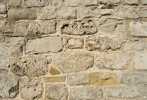For this church:    |
| |||||||||||||||||||||
 Tufa stone Tufa stone |
 Lias possibly from Collingham is found in small amounts in the south wall.
Lias possibly from Collingham is found in small amounts in the south wall.
 All roofs are made of Cumberland slate.
All roofs are made of Cumberland slate.
Interior
Most of the internal stonework is Magnesian limestone, including the south arch and window sills. There is also unusually internal use of tufa around the arches. The tower opening and all the carved work are of Mansfield limestone. The dressing stones of the chancel are of oolitic limestone.
Particular items are constructed as follows:
| Pulpit: | Lincolnshire limestone, softer than Ancaster limestone. | ||
 |
|||
| Tombstones in south aisle: |
Carboniferous sandstone, possibly from Elland, near Halifax. Slabs of this kind unlikely to have come from Derbyshire quarries | ||
 |
|||
| Font: | Sandstone, millstone grit, very hard to work hence no ornamentation. It is possibly thirteenth century, from original church. Pedestal of magnesian limestone; there is some evidence of painting. | ||
Associated buildings
The War Memorial alongside main church gate is made from skerry blocks taken from the chancel of Caunton Old Church. The stones are likely to have been cut in the 13th Century. The base is also made of skerry blocks.
Blocks of skerry can also be seen in the lower courses of the walls of The Grange.






